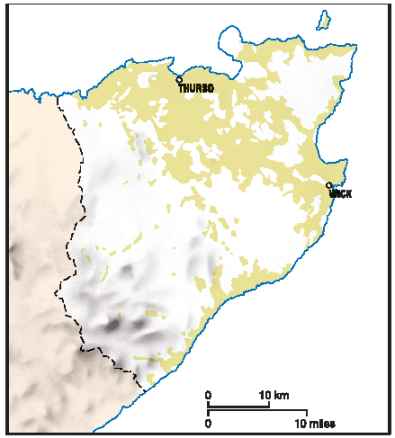|
FARM AND CROFT LAND
Arable Crops and field margins
Habitats
and species
Caithness is one of the few areas in the Highlands that still support
mixed farming and crofting. The production of a range of crops along with
the rearing of cattle and sheep is the key to the richness and variety of
wildlife that we see on agricultural land in the county. If this system is
lost, so too will be the diversity of habitats and there will be a
detrimental change in the structure of the countryside.
The relatively uniform crop
structure and low species diversity produced by intensive arable cropping
provides a limited habitat for wildlife. If unsprayed areas are kept,
cultivated fields can support a flora of annual weeds, including the
nationally rare purple ramping fumitory, which provide seeds and attract
insects for bird-life.
The prevalence of spring planted
crops is beneficial to over-wintering birds due to the presence of stubble
for much of the winter, acting like a giant bird table.

Field of Oats, Calder
The stubble left after the crop has been combined
gives cover and a welcome source of food for small passerines such as
brambling, chaffinch and greenfinch. Resident greylag and migrant
Greenland white-fronted geese also benefit from the growing of oats or
barley.
The field margins
offer a wider range of habitats to wildlife and plantlife.
Hedges and dykes provide a refuge for
plants, insects and small mammals, as well as acting as wildlife
corridors. Ditches and streams provide
valuable habitats for flowering plants that in-turn support invertebrates
such as butterflies and beetles.
Field margins such as conservation headlands -
where the outermost strip of the crop is managed to control weeds rather
than eradicate them, and grass margins - where an undisturbed grass strip
is established around the field edge, are both valuable tools that improve
biodiversity on arable and mixed farms. Birds such as quail and partridge
benefit from such management.
Farm buildings also provide a roosting or nesting
habitat for owls, swallows, swifts and house martins.

Farmland at Stemster
Main issues
-
Due to the current economic
problems facing the agricultural industry, the rural population is
declining and with it we are experiencing a closure of rural services,
reduction in the work force and loss of traditional land management
skills. Farmers and crofters are stewards of the environment and without
them, the loss of habitats and associated species would be great.
-
In some areas, sheep have largely
replaced cattle, and inbye croft land is becoming under managed. A
continued decline in cattle, and the associated loss in cropping, will
have particularly adverse effects on the area’s biodiversity.
-
Mechanisation and intensification
of crop production is leaving less waste on the fields. A reduction in
crop rotation and decline in under-sowing of cereal crops to produce a
grass ley is leading to a reduction in the diversity of management both
across the farm and through the year, leading to a corresponding
reduction in biodiversity.
-
Nutrient run-off from fertilisers
can cause problems far beyond the farm boundary. The widespread use of
pesticides in some parts of the country has been associated with the
severe decline in populations of farmland birds, largely due to the
effects on their food supply.
-
It is no longer viable to employ
a large workforce to maintain hedgerows, dykes and other features used
by wildlife. This is leading to the loss and neglect of hedges and
drystone and flagstone boundary walls.
|

Habitat Map
Current biodiversity projects
Many farmers and crofters continue to manage their land for wildlife as
well as food production. The fact that Caithness has retained a number of
small farmers and crofters, and that they continue to cultivate small
fields, has benefited wildlife.
However, with increasing social and economic pressures
on these small units, this type of agriculture is becoming more
threatened. 
Harvester, Quoys of Reiss
Agri-environmental schemes such as the Rural
Stewardship Scheme provide some income for such management. However such
schemes are, at present, drastically under-funded and biased towards
larger farms with a more diverse range of habitats to the exclusion of
smaller farms and crofts with only one or two important habitats.

Meadow pipit on gorse
Opportunities for action
- Create ‘conservation headlands’ and wider grass
margins around arable fields.
- Plant game cover or seed-bearing crops such as
linseed on set-aside land, to provide a source of food and cover for
wintering birds.
- Encourage traditional cropping methods (e.g.
Spring crops, late ploughing) to provide valuable winter stubble. After
establishment, allow weedy plants to remain in root crops as their seeds
are a very valuable source of food for birds in winter.
- Increase funding towards the establishment and
upkeep of hedges and other countryside features, which provide shelter
and wildlife corridors for many species, perhaps on a pilot,
demonstration basis.
- Encourage the retention of small farm quarries
and ponds, and the repair and construction of vernacular buildings and
flagstone and drystone dykes, both as landscape features and as valuable
habitats for wildlife.
- Encourage best practice for land managers
allowing wildfowling on their land through the production of leaflets
and site visits, and raise awareness of the protection of Greenland
white-fronted geese.
- Produce Caithness-specific advice on habitat
management for locally important species, e.g. twite.
- Investigate the relationship between
biodiversity and bio-fuel crops through local trials.
- Facilitate nutrient budgeting plans, to help
farmers utilise manure and reduce dependence on fertilisers, encourage
the return to clover rich pastures requiring less fertilisers.
- Encourage sparrow counts around schools,
villages and neighbouring farms.
|
|




